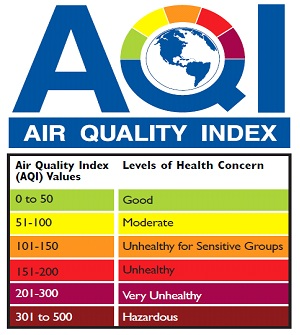The Air Quality Index
The AQI is an index for reporting daily air quality. It tells you how clean or polluted your air is, and what associated health effects might be a concern for you. The AQI focuses on health effects you may experience within a few hours or days after breathing polluted air. EPA calculates the AQI for five major air pollutants regulated by the Clean Air Act: ground-level ozone, particle pollution (also known as particulate matter), carbon monoxide, sulfur dioxide, and nitrogen dioxide. For each of these pollutants, EPA has established national air quality standards to protect public health.
How Does the AQI Work?
Think of the AQI as a yardstick that runs from 0 to 500. The higher the AQI value, the greater the level of air pollution and the greater the health concern. For example, an AQI value of 50 represents good air quality with little potential to affect public health, while an AQI value over 300 represents hazardous air quality.
An AQI value of 100 generally corresponds to the national air quality standard for the pollutant, which is the level EPA has set to protect public health. AQI values below 100 are generally thought of as satisfactory. When AQI values are above 100, air quality is considered to be unhealthy-at first for certain sensitive groups of people, then for everyone as AQI values get higher.

Understanding the AQI
The purpose of the AQI is to help you understand what local air quality means to your health. To make it easier to understand, the AQI is divided into six categories. Each category corresponds to a different level of health concern. The levels of health concern and what they mean are:
“Good” The AQI value for your community is between 0 and 50. Air quality is considered satisfactory, and air pollution poses little or no risk.
“Moderate” The AQI for your community is between 51 and 100. Air quality is acceptable; however, for some pollutants there may be a moderate health concern for a very small number of people. For example, people who are unusually sensitive to ozone may experience respiratory symptoms.
“Unhealthy for Sensitive Groups” When AQI values are between 101 and 150, members of sensitive groups may experience health effects. This means they are likely to be affected at lower levels than the general public. For example, people with lung disease are at greater risk from exposure to ozone, while people with either lung disease or heart disease are at greater risk from exposure to particle pollution. The general public is not likely to be affected when the AQI is in this range.
“Unhealthy” Everyone may begin to experience health effects when AQI values are between 151 and 200. Members of sensitive groups may experience more serious health effects.
“Very Unhealthy” AQI values between 201 and 300 trigger a health alert, meaning everyone may experience more serious health effects.
“Hazardous” AQI values over 300 trigger health warnings of emergency conditions. The entire population is more likely to be affected.
Air Quality & Health
Local air quality affects how you live and breathe. Like the weather, it can change from day to day or even hour to hour. The Lawton Metropolitan Area Air Quality Committee and the EPA are working to make information about outdoor air quality as easy to understand as the weather forecast. A key tool in this effort is the Air Quality Index or AQI. We use the AQI to provide you with simple information on local air quality, the health concerns for different levels of air pollution, and how you can protect your health when pollutants reach unhealthy levels.
Learn more about:
Downloads
Links
